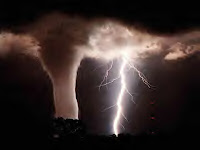The weather wars are heating up—or getting frosty, or hailing down, or whatever your favorite weather-related cliché may be. Let’s just say they’re getting bad.
At midnight on Jan. 14, DirecTV dropped the Weather Channel from its service, replacing it with a service called WeatherNation. The move left an estimated 20 million people without access to the Weather Channel and gave WeatherNation, a two-year-old upstart out of Colorado, a national audience almost overnight. WeatherNation currently airs the weather on a three-hour taped loops and does not report live.
After news of the conflict broke, AccuWeather, the Pennsylvania-based company that currently supplies forecasts to 175,000 paying clients and several hundred local TV stations around the country, announced plans to join into the 24-hour weather market by launching its own TV network sometime in September. “We’ve been planning for some time to do this,” says Barry Myers, CEO of AccuWeather, “but it was clear that to keep silent about it, given the [dispute between DirecTV and the Weather Channel] wouldn’t make sense.” AccuWeather’s new station will stick to straight, no-nonsense forecasts, fashioning itself as the brainy alternative to the Weather Channel, which in recent years has strayed into the reality show market with shows such as Storm Stories and Lifeguard! Southern California.
Myers says he’s still in the process of negotiating deals with cable providers and doesn’t yet know how many of them will end up carrying AccuWeather’s network. But if the DirecTV dispute is any indication, AccuWeather may be poised to steal a good share of the Weather Channel’s market. If that happens, the Weather Channel’s thirty year monopoly on television may finally come to an end.
But do people really need two weather channels? The immediate, reflexive answer to that is probably ‘No.’ It’s either raining or it’s not, and you don’t have to check multiple sources to find out which one is true. At the same time, TV networks have been underestimating people’s interest in the weather for decades. When AccuWeather started in 1962, “people said I was crazy, that no one was going to pay for something the National Weather Service provided for free,” Joel Meyers, AccuWeather’s founder told me recently. “I remember pitching AccuWeather to TV stations in the early days. They’d tell me, ‘Eh, people aren’t that interested in weather.’” The Weather Channel encountered the same problem when it debuted in 1982. In fact, four months after it launched, the New York Times ran a tongue-in-cheek list of its hopes for the future of television, including “Offer one convincing justification for cable TV’s ‘The Weather Channel.’”
While the Weather Channel and AccuWeather haven’t competed directly on television like this before, their websites and mobile apps have gone head-to-head for a while. Online, the Weather Channel is still bigger, with 89 million unique visitors compared to AccuWeather’s 11 million, but the latter caters to businesses and weather nerds with its broader range of forecast periods, from 45-day estimates to minute-by-minute updates. Over the past few years, the Weather Channel worked very hard to maintain its lead. In 2012 it started naming regular winter storms, essentially strong-arming its competition into either adopting its made-up names (which started with Athena and went all the way through Zeus) or fade into irrelevance without them. That may be AccuWeather’s biggest hurdle in the TV market. When a big storm hits, who’s going to tune into a no-name forecast when they can watch someone stand out in the snow, describing the horrors of Zeus?
